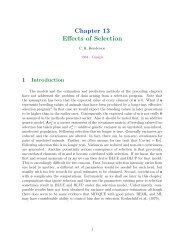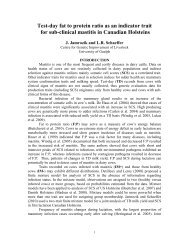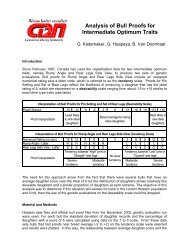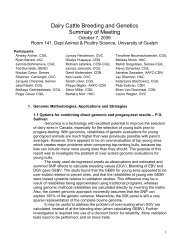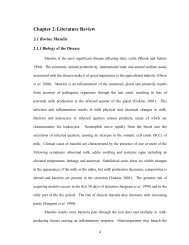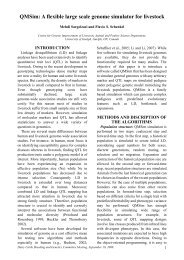A principal component regression based genome wide analysis ...
A principal component regression based genome wide analysis ...
A principal component regression based genome wide analysis ...
You also want an ePaper? Increase the reach of your titles
YUMPU automatically turns print PDFs into web optimized ePapers that Google loves.
BTA10 and BTA11 [74,77]; and for somatic cell score on BTA1, BTA5,<br />
BTA6, and BTA14 [78,79] are situated in the vicinity of some of the<br />
putative QTL regions described in this study. This indicates that some<br />
of these putative QTLs could also influence other important disease<br />
traits in cattle populations.<br />
The application of WGA <strong>analysis</strong> to identify QTLs for complex<br />
disease traits presents many difficulties pertaining to the sample size,<br />
selection of animals in the healthy and diseased cohorts, choice of<br />
markers for genotyping, and the type of model used to analyze the<br />
data. Specifically, in the case of mapping QTLs for MAP resistance in<br />
dairy cattle, the basis of classifying animals into diseased and healthy<br />
cohorts is a major concern. Available diagnostic tests are specific but<br />
lack desired sensitivity. This means that while positive results are<br />
indicative of MAP infection, negative results do not necessarily<br />
indicate that the animals are free of infection. This is especially true<br />
for younger infected animals that do not manifest any noticeable<br />
symptoms during the sub-clinical stages of infection. Some of these<br />
animals could potentially escape detection by the common ELISA<br />
diagnostic kits, and could thus be misclassified as being healthy (false<br />
negatives). To mitigate the inclusion of such false negatives, we<br />
avoided the inclusion of younger animals (b5.8 years) in our healthy<br />
cohort (mean age=7.3 years). In addition, more than two-thirds of<br />
the healthy cohort had tested negative for MAP infection in previous<br />
years. Another potential concern regarding the healthy cohort is that<br />
healthy animals do not necessarily reflect enhanced genetic resistance<br />
to MAP. Animals coming from farms or herds with no prevalence of<br />
MAP will also test negative for MAP infection. In such cases, it is the<br />
absence of exposure to MAP, rather than enhanced genetic resistance<br />
of the animals, that translates into a negative test result. Therefore, in<br />
our study, animals that were classified as being healthy were only<br />
picked from farms with a high prevalence of MAP infection in the<br />
herd, ensuring the exposure of healthy animals.<br />
Two previously published studies have attempted to map QTLs for<br />
MAP resistance in cattle using microsatellite and SNP markers [36,37].It<br />
is known that multiallelic markers like microsatellites are more<br />
informative than bi-allelic markers like SNPs. We used SNPs in our<br />
study as they are relatively abundant in the <strong>genome</strong> and because an<br />
automated, high-throughput and cost-effective genotyping technology<br />
is available. The Illumina BovineSNP50 BeadChip used in this study<br />
contained 54,001 SNPs. It has been estimated that 10,000 SNPs are<br />
sufficient to find associations within cattle breeds [39]. Sinceourstudy<br />
focused on a single breed (Holsteins), the number of markers on the<br />
Illumina BovineSNP50 BeadChip provided sufficient power to our study.<br />
Strict quality control (QC) measures were implemented prior to<br />
data analyses. All SNPs with a minor allele frequency (MAF) less than<br />
10%, and all SNPs and individual animals with a genotype call rate of<br />
less than 95% were removed from the dataset prior to <strong>analysis</strong>.<br />
However, none of the animals were removed due to QC, as all animals<br />
had a genotype call rate of N95%. It is important to exclude SNPs with<br />
low MAF, especially in studies with a limited sample size in order to<br />
control type-I error. Insufficient observations to compute the<br />
estimates for rare alleles could potentially produce inflated estimates<br />
and spurious associations. This seems to be evident in the study<br />
published by Settles et al., who used the Illumina BovineSNP50<br />
BeadChip to map QTLs for MAP resistance in Holstein cattle, but used a<br />
threshold of 1% for MAF during QC [37]. Consequently, 5 out of the<br />
16 SNPs that were reported to be associated with MAP infection<br />
status, have a MAF of 1% with unrealistically high odds ratios, and are<br />
most likely spurious associations. A potential pitfall of using a high<br />
threshold for the MAF, is the possibility of overlooking rare disease<br />
alleles that might be in LD with the some of the markers that are<br />
excluded from the analyses due to low MAF [80]. However, within the<br />
limitations of the available sample size of our study, it would not have<br />
been possible for us to distinguish between rare alleles showing<br />
spurious associations and rare disease alleles having a true association<br />
with the disease phenotype.<br />
S.D. Pant et al. / Genomics 95 (2010) 176–182<br />
We performed statistical <strong>analysis</strong> using a two-step logistic<br />
<strong>regression</strong> approach. In the first step, SNPs were tested for association<br />
with the disease phenotype, one at a time. In the second step, all SNPs<br />
found to be associated at pb0.05 in the first step, were re-analyzed,<br />
fitting PCs of SNPs that were also associated at pb0.05, and were on<br />
the same chromosome, as covariates. Our choice of logistic <strong>regression</strong><br />
over other traditional case-control analytical techniques was <strong>based</strong> on<br />
two main reasons. First, logistic <strong>regression</strong> allows for joint <strong>analysis</strong> of<br />
multiple loci and second, it mitigates the effect of population<br />
substructure without a significant loss in power [81]. Accounting for<br />
population substructure was necessary since the pedigree of the<br />
resource population was unavailable due to client anonymity, and<br />
hence population substructure could potentially confound the<br />
analyses resulting in a higher type-I error rate.<br />
Since we were limited by the number of animals in our resource<br />
population (n=232), a preliminary step was required in our analyses<br />
to remove the majority of SNPs that were not associated with the<br />
disease trait. Computation of PCs of thousands of SNPs (34,759 in our<br />
study), <strong>based</strong> on the genotypes of a few hundred animals (232 in our<br />
study), results in PCs that individually explain very minute proportions<br />
of the total genotypic variance. Since inclusion of such PCs in the<br />
<strong>regression</strong> model leads to a perfect prediction the disease phenotype,<br />
resulting in almost infinite likelihoods and inaccurate estimates [82],<br />
the first step in our analyses was necessary to overcome this problem.<br />
The second step of the analyses was similar to the PCReg approach<br />
proposed by Wang and Abbot for quantitative traits [43]. Although<br />
PCs are able to summarize the total variance of the original genotype<br />
scores, and remain orthogonal, the PCReg approach only assesses the<br />
association between the disease phenotype and all SNPs used to<br />
compute the PCs, as a whole. Therefore, interpretations about the<br />
importance of individual SNPs cannot be made, <strong>based</strong> on the<br />
associations shown by PCs that are computed from them [83]. Joint<br />
<strong>analysis</strong> of an individual SNP along with PCs computed from the<br />
genotype covariance matrix of the rest of the SNPs on a chromosome,<br />
allows the multiple <strong>regression</strong> model to account for correlation<br />
between SNPs (which is mostly due to LD), without suffering from<br />
severe multicollinearity. Also, by fitting individual SNPs along with<br />
the PCs derived from the rest of the SNPs on the same chromosome,<br />
we avoided making any interpretation about the PCs and were able to<br />
test the association between the disease phenotype and individual<br />
SNPs while accounting for the association of the rest of the SNPs on<br />
the same chromosome.<br />
Conclusions<br />
In conclusion, this GWA study, like the earlier two studies that<br />
were published <strong>based</strong> on a GWA approach, is an early attempt to<br />
reveal putative candidate genes that could play a role in conferring<br />
resistance to MAP infection in cattle populations. The statistical<br />
approach used in this study can accommodate for LD and thus, could<br />
be extended to other case-control association studies where accounting<br />
for LD among genetic markers is a problem. Our objectives were<br />
limited to identifying putative candidate genes that could be<br />
investigated further in future candidate gene studies. Once the role<br />
of such candidates is firmly established and characterized, variation<br />
within these genes could be exploited in order to make cattle<br />
populations more resistant to MAP infections for the benefit of the<br />
livestock industry.<br />
Materials and methods<br />
Resource population<br />
Six commercial operations in Southwestern and Eastern Ontario<br />
were selected for sample collection <strong>based</strong> on a previous history of<br />
high prevalence of MAP infection. Blood was collected between the<br />
179





